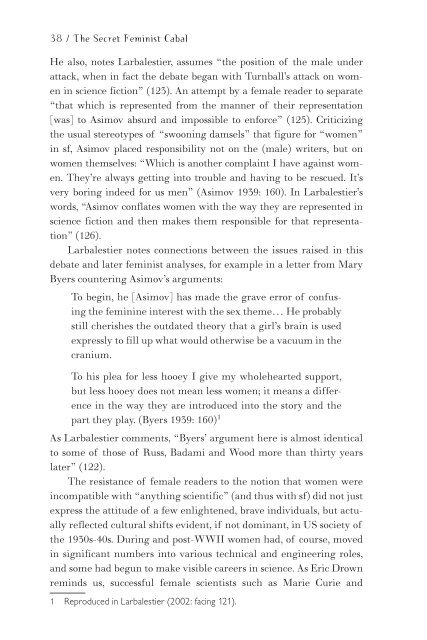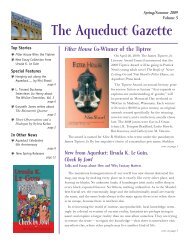Feminist Ca
Read Chapters Two and Three - Aqueduct Press
Read Chapters Two and Three - Aqueduct Press
- No tags were found...
Create successful ePaper yourself
Turn your PDF publications into a flip-book with our unique Google optimized e-Paper software.
38 / The Secret <strong>Feminist</strong> <strong>Ca</strong>bal<br />
He also, notes Larbalestier, assumes “the position of the male under<br />
attack, when in fact the debate began with Turnball’s attack on women<br />
in science fiction” (123). An attempt by a female reader to separate<br />
“that which is represented from the manner of their representation<br />
[was] to Asimov absurd and impossible to enforce” (125). Criticizing<br />
the usual stereotypes of “swooning damsels” that figure for “women”<br />
in sf, Asimov placed responsibility not on the (male) writers, but on<br />
women themselves: “Which is another complaint I have against women.<br />
They’re always getting into trouble and having to be rescued. It’s<br />
very boring indeed for us men” (Asimov 1939: 160). In Larbalestier’s<br />
words, “Asimov conflates women with the way they are represented in<br />
science fiction and then makes them responsible for that representation”<br />
(126).<br />
Larbalestier notes connections between the issues raised in this<br />
debate and later feminist analyses, for example in a letter from Mary<br />
Byers countering Asimov’s arguments:<br />
To begin, he [Asimov] has made the grave error of confusing<br />
the feminine interest with the sex theme… He probably<br />
still cherishes the outdated theory that a girl’s brain is used<br />
expressly to fill up what would otherwise be a vacuum in the<br />
cranium.<br />
To his plea for less hooey I give my wholehearted support,<br />
but less hooey does not mean less women; it means a difference<br />
in the way they are introduced into the story and the<br />
part they play. (Byers 1939: 160) 1<br />
As Larbalestier comments, “Byers’ argument here is almost identical<br />
to some of those of Russ, Badami and Wood more than thirty years<br />
later” (122).<br />
The resistance of female readers to the notion that women were<br />
incompatible with “anything scientific” (and thus with sf) did not just<br />
express the attitude of a few enlightened, brave individuals, but actually<br />
reflected cultural shifts evident, if not dominant, in US society of<br />
the 1930s-40s. During and post-WWII women had, of course, moved<br />
in significant numbers into various technical and engineering roles,<br />
and some had begun to make visible careers in science. As Eric Drown<br />
reminds us, successful female scientists such as Marie Curie and<br />
1 Reproduced in Larbalestier (2002: facing 121).




